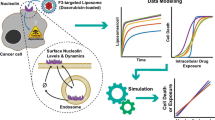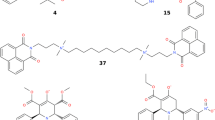Abstract
Lysosomes are acidic organelles and are involved in various diseases, the most prominent is malaria. Accumulation of molecules in the cell by diffusion from the external solution into cytosol, lysosome and mitochondrium was calculated with the Fick–Nernst–Planck equation. The cell model considers the diffusion of neutral and ionic molecules across biomembranes, protonation to mono- or bivalent ions, adsorption to lipids, and electrical attraction or repulsion. Based on simulation results, high and selective accumulation in lysosomes was found for weak mono- and bivalent bases with intermediate to high log K ow. These findings were validated with experimental results and by a comparison to the properties of antimalarial drugs in clinical use. For ten active compounds, nine were predicted to accumulate to a greater extent in lysosomes than in other organelles, six of these were in the optimum range predicted by the model and three were close. Five of the antimalarial drugs were lipophilic weak dibasic compounds. The predicted optimum properties for a selective accumulation of weak bivalent bases in lysosomes are consistent with experimental values and are more accurate than any prior calculation. This demonstrates that the cell model can be a useful tool for the design of effective lysosome-targeting drugs with minimal off-target interactions.







Similar content being viewed by others
References
ACD Advanced Chemistry Development Inc. Toronto, Canada. 2007. ACD/LogD Suite version 10.02. http://www.acdlabs.com/. Accessed 12 April 2008
Appelo CAJ, Postma D (1999) Geochemistry and groundwater pollution, 4 edn. Balkema, Rotterdam
Briggs GE, Hope AB, Robertson RN (1961) Electrolytes and plant cells. In: James WO (ed.) Botanical monographs, vol. 1. Blackwell, Oxford, UK
Chen VY, Rosania GR (2006) The great multidrug-resistance paradox. ACS Chem Biol 1:271–273
Colombo MI, Bertini F (1988) Properties of binding sites for chloroquine in liver lysosomal membranes. J Cell Physiol 137:598–602
Debye P, Hückel E (1923) Zur Theorie der Elektrolyte. Z Physikal Chem 24:185–206
De Duve C, De Barsy T, Poole B, Trouet A, Tulkens P, Van Hoof F (1974) Commentary. Lysosomotropic agents. Biochem Pharmacol 23:2495–2531
Duvvuri M, Gong Y, Chatterji D, Krise JP (2004) Weak base permeability characteristics influence the intracellular sequestration site in the multidrug-resistant human leukemic cell line HL-60. J Biol Chem 279:32367–32372
Duvvuri M, Krise JP (2005a) Intracellular drug sequestration events associated with the emergence of multidrug resistance: a mechanistic review. Front Biosci 10:1499–1509
Duvvuri M, Krise JP (2005b) A novel assay reveals that weakly basic model compounds concentrate in lysosomes to an extent greater than pH-partitioning theory would predict. Mol Pharm 2:440–448
Duvvuri M, Konkar S, Funk RS, Krise JM, Krise JP (2005) A chemical strategy to manipulate the intracellular localization of drugs in resistant cancer cells. Biochemistry 44:15743–15749
Ginsburg H, Ward SA, Bray PG (1999) An integrated model of chloroquine action. Parasitol Today 15:357–360
Goldman DE (1943) Potential, impedance and rectification in membranes. J Gen Physiol 27:37–60
Hansch C, Leo A, Hoekman D (1995) Exploring QSAR: fundamentals and applications in chemistry and biology. American Chemical Society, Washington DC
Henderson LJ (1908) Concerning the relationship between the strength of acids and their capacity to preserve neutrality. J Physiol 21:173–179
Hodgkin AL, Katz B (1949) The effect of sodium ions on the electrical activity of the giant axon of the squid. J Physiol 108:37–77
Horobin RW, Stockert JC, Rashid-Doubell F (2006) Fluorescent cationic probes for nuclei of living cells: why are they selective? A quantitative structure–activity relations analysis. Histochem Cell Biol 126:165–175
Horobin RW, Trapp S, Weissig V (2007) Mitochondriotropics: a review of their mode of action, and their applications for drug and DNA delivery to mammalian mitochondria. J Control Release 121:125–136
Ishizaki J, Yokogawa K, Ichimura F, Ohkuma S (2000) Uptake of imipramine in rat liver lysosomes in vitro and its inhibition by basic drugs. J Pharmacol Exp Ther 294:1088–1098
Kaufmann AM, Krise JP (2007) Lysosomal sequestration of amine-containing drugs: analysis and therapeutic implications. J Pharm Sci 96:729–746
Kornhuber J, Medlin A, Bleich S, Jendrossek V, Henkel AW, Wiltfang J, Gulbins E (2005) High activity of acid sphingomyelinase in major depression. J Neural Transm 112:1583–1590
Kornhuber J, Tripal P, Reichel M, Bleich S, Wiltfang J, Gulbins E (2008) Identification of new functional inhibitors of acid sphingomyelinase using a structure-property-activity relation model. J Med Chem 51:219–237
Lemieux B, Percival MD, Falgueyret J-P (2004) Quantification of the lysosomotropic character of cationic amphiphilic drugs using the fluorescent basic amine Red DND-99. J Pharmacol Exp Ther 294:247–251
MacIntyre AC, Cutler DJ (1988) The potential role of lysosomes in tissue distribution of weak bases. Biopharm Drug Dispos 9:513–526
Newton DW, Kluza RB (1978) pKa values of medicinal compounds in pharmacy practice. Drug Intell Clin Pharm 12:547–554
Ohkuma S, Poole B (1978) Fluorescence probe measurement of the intralysosomal pH in living cells and the perurbation of pH by various agents. Proc Natl Acad Sci USA 75:3327–3331
Poole B, Ohkuma S (1981) Effect of weak bases on the intralysosomal pH in mouse peritoneal macrohages. J Cell Biol 90:665–669
Raven JA (1975) Transport of indolacetic acid in plant cells in relation to pH and electrical potential gradients, and its significance for polar IAA transport. New Phytol 74:163–172
Rashid F, Horobin RW (1991) Accumulation of fluorescent non-cationic probes in mitochondria of cultured cells: observations, a proposed mechanism and some implications. J Microsc 163:233–241
Rodgers T, Leahy D, Rowland M (2005) Physiologically based pharmacokinetic modeling: predicting the tissue distribution of moderate-to-strong bases. J Pharmaceut Sci 94:1259–1276
Rosenberg LS, Schulman SG (1978) Tautomerism of singly protonated chloroquine and quinacrine. J Pharm Sci 67:1770–1772
Saparov SM, Antonenko YM, Pohl P (2006) A new model of weak acid permeation through membranes revisited: does overton still rule? Biophys J Biophys Lett. doi:10.1529/biophysj.106.084343
Slater AF (1993) Chloroquine: mechanism of drug action and resistance in Plasmodium falciparum. Pharmacol Ther 57:203–235
Sugioka Y, Suzuki M, Sugioka K, Nakano M (1987) A ferriprotoporphyrin IX-chloroquine complex promotes membrane phospholipid peroxidation. A possible mechanism for antimalarial action. FEBS Lett 223:251–254
Trapp S (2004) Plant uptake and transport models for neutral and ionic chemicals. Environ Sci Pollut Res 11:33–39
Trapp S. Horobin RW (2005) A predictive model for the selective accumulation of chemicals in tumor cells. Eur Biophys J 34:959–966
White NJ (1985) Clinical pharmacokinetics of antimalarial drugs. Clin Pharmacokinet 10:187–215
Van Dyke RW (1988) Proton pump-generated electrochenical gradients in rat liver multivesicular bodies. J Biol Chem 263:2603–2611
Zhang J, Krugliak M, Ginsburg H (1999) The fate of ferriprotorphyrin IX in malaria infected erythrocytes in conjunction with the mode of action of antimalarial drugs. Mol Biochem Parasitol 99:129–141
Zhang X, Shedden K, Rosania GR (2006) A cell-based molecular transport simulator for pharmacokinetic prediction and cheminformatic exploration. Mol Pharm 3:704–716
Acknowledgments
We wish to acknowledge Prof. W. Martin at the Division of Neuroscience and Biomedical Systems, IBLS, University of Glasgow for providing facilities to one of us (RWH). The study was partly funded by the European Commission, 6th Framework program, project OSIRIS [GOCE contract number 037017]. G. R. Rosania would like to acknowledge financial support from NIH grants RO1-GM078200 and P20-HG003890. Antonio Franco assisted with the ACD calculations. Thanks to Muralikrishna Duvvuri for providing raw data of experiments.
Author information
Authors and Affiliations
Corresponding author
Rights and permissions
About this article
Cite this article
Trapp, S., Rosania, G.R., Horobin, R.W. et al. Quantitative modeling of selective lysosomal targeting for drug design. Eur Biophys J 37, 1317–1328 (2008). https://doi.org/10.1007/s00249-008-0338-4
Received:
Revised:
Accepted:
Published:
Issue Date:
DOI: https://doi.org/10.1007/s00249-008-0338-4




